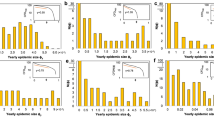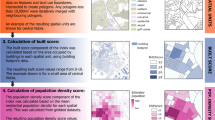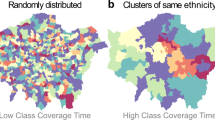Abstract
Background/Objectives:
Recent evidence suggests clustering of human body height. We want to assess the consequences of connectedness in a spatial network on height clustering in an artificial society.
Subjects/Methods:
We used an agent-based computer modelling technique (Monte Carlo simulation) and compared simulated height in a spatial network with characteristics of the observed geographic height distribution of three historic cohorts of Swiss military conscripts (conscripted in 1884–1891; 1908–1910; and 2004–2009).
Results:
Conscript height shows several characteristic features: (1) height distributions are overdispersed. (2) Conscripts from districts with direct inter-district road connections tend to be similar in height. (3) Clusters of tall and clusters of short stature districts vary over time. Autocorrelations in height between late 19th and early 21st century districts are low. (4) Mean district height depends on the number of connecting roads and on the number of conscripts per district. Using Monte Carlo simulation, we were able to generate these natural characteristics in an artificial society. Already 5% height information from directly connected districts is sufficient to simulate the characteristics of natural height distribution. Very similar observations in regular rectangular networks indicate that the characteristics of Swiss conscript height distributions do not so much result from the particular Swiss geography but rather appear to be general features of spatial networks.
Conclusions:
Spatial connectedness can affect height clustering in an artificial society, similar to that seen in natural cohorts of military conscripts, and strengthen the concept of connectedness being involved in the regulation of human height.
This is a preview of subscription content, access via your institution
Access options
Subscribe to this journal
Receive 12 print issues and online access
$259.00 per year
only $21.58 per issue
Buy this article
- Purchase on Springer Link
- Instant access to full article PDF
Prices may be subject to local taxes which are calculated during checkout






Similar content being viewed by others
References
Christakis NA, Fowler JH . The spread of obesity in a large social network over 32 years. N Engl J Med 2007; 357: 370–379.
Christakis NA, Fowler JH . The collective dynamics of smoking in a large social network. N Engl J Med 2008; 358: 2249–2258.
Christakis NA, Fowler JH . Social contagion theory: examining dynamic social networks and human behavior. Stat Med 2013; 32: 556–577.
Aßmann C, Hermanussen M . Modeling determinants of growth: evidence for a community-based target in height? Pediatr Res 2013; 74: 88–95.
Hermanussen M, Alt C, Staub K, Aßmann C, Groth D . The impact of physical connectedness on body height in Swiss conscripts. Anthropol Anz 2014; 71: 313–327.
Bogin B, Hermanussen M, Blum WF, Aßmann C . Sex, Sport, IGF-1 and the Community Effect in Height Hypothesis. Int J Environ Res Public Health 2015; 12: 4816–4832.
Epstein JM, Axtell R . Growing Artificial Societies. Brookings Institution Press: Washington, DC, USA, 1996.
Staub K, Rühli F, Woitek U, Pfister C . The average height of 18- and 19-year old conscripts (N=458 322) in Switzerland, 1992–2009, and the secular height trend since 1878. Swiss Med Wkly 2011; 141: w13238.
Aßmann C . In: Hermanussen M (ed) Auxology—Studying Human Growth and Development. Schweizerbart: Stuttgart, Germany, 2013, p 72.
Breusch TS, Pagan AR . A simple test for heteroscedasticity and random coefficient variation. Econometrica 1979; 47: 1287–1294.
Goodreau SM, Handcock MS, Hunter DR, Butts CT, Morris M . Statnet tutorial. J Stat Softw 2008; 24: 1–26.
Handcock MS, Hunter DR, Butts CT, Goodreau SM, Morris M . Statnet. 2003 Software tools for the Statistical Modeling of Network Data. Available at http://statnetproject.org.
R Development Core Team R A Language and Environment for Statistical Computing. R Foundation for Statistical Computing: Vienna, Austria, 2011 Available at http://www.R-project.org/.
Csardi G, Nepusz T . The igraph software package for complex network research. InterJournal 2006; 1695. Available at http://igraph.sf.net.
Bogin BA . . Patterns of Human Growth. 2nd edn. Cambridge University Press: Cambridge, UK, 1999.
Smith JM . Evolutionary Genetics. Oxford University Press: Oxford, UK, 1999.
Wood AR, Esko T, Yang J, Vedantam S, Pers TH, Gustafsson S et al. Defining the role of common variation in the genomic and biological architecture of adult human height. Nat Genet 2014; 46: 1173–1186.
Richards EJ . Inherited epigenetic variation — revisiting soft inheritance. Nature Reviews Genetics 2006; 7: 395–401.
Crews D, Gore AC . In: Tollefsbol (ed). Transgenerational Epigenetics. Elsevier: Amsterdam, The Netherlands, 2014.
Fogel RW . The Escape from Hunger and Premature Death, 1700–2100. Cambridge University Press: Cambridge, New York, Melbourne, 2004.
Floud R . The heights of Europeans since 1750: a new source for European economic history. In: Komlos J (ed). Stature, Living Standards, and Economic Development: Essays in Anthropometric History. The University of Chicago Press: Chicago, IL, USA, 1994, pp 9–24.
Komlos J . Height and social status in eighteenth-century Germany. J Interdisciplinary Hist 1990; 20: 607–621.
Komlos J . Stature, living standards, and economic development Essays in Anthropometric History. University of Chicago Press: Chicago, IL, USA, 1994.
Gamboa MI, Giambelluca LA, Navone GT . Spatial distribution of intestinal parasites in the City of La Plata, Argentina. Medicina (B Aires) 2014; 74: 363–370.
Cacciari E, Milani S, Balsamo A, Spada E, Bona G, Cavallo L et al. Italian cross-sectional growth charts for height, weight and BMI (2 to 20 yr). J Endocrinol Invest 2006; 29: 581–593.
Rebato E . The studies on secular trend in Spain: a review. In: Bodzsar EB, Susanne C (eds). Secular Growth Changes in Europe. Eötvös University Press: Budapest, Hungary, 1998, pp 297–317.
Acknowledgements
This work was supported by Deutsche Gesellschaft für Auxologie (Auxological Society).
Author contributions
MH, DG and CA had the original idea for the studies. DG and CA contributed to the design. MH drafted the manuscript, which was revised by all authors. All authors read and approved the final manuscript.
Author information
Authors and Affiliations
Corresponding author
Ethics declarations
Competing interests
The authors declare no conflict of interest.
Rights and permissions
About this article
Cite this article
Hermanussen, M., Aßmann, C. & Groth, D. Monte Carlo simulation of body height in a spatial network. Eur J Clin Nutr 70, 671–678 (2016). https://doi.org/10.1038/ejcn.2016.45
Received:
Revised:
Accepted:
Published:
Issue Date:
DOI: https://doi.org/10.1038/ejcn.2016.45



